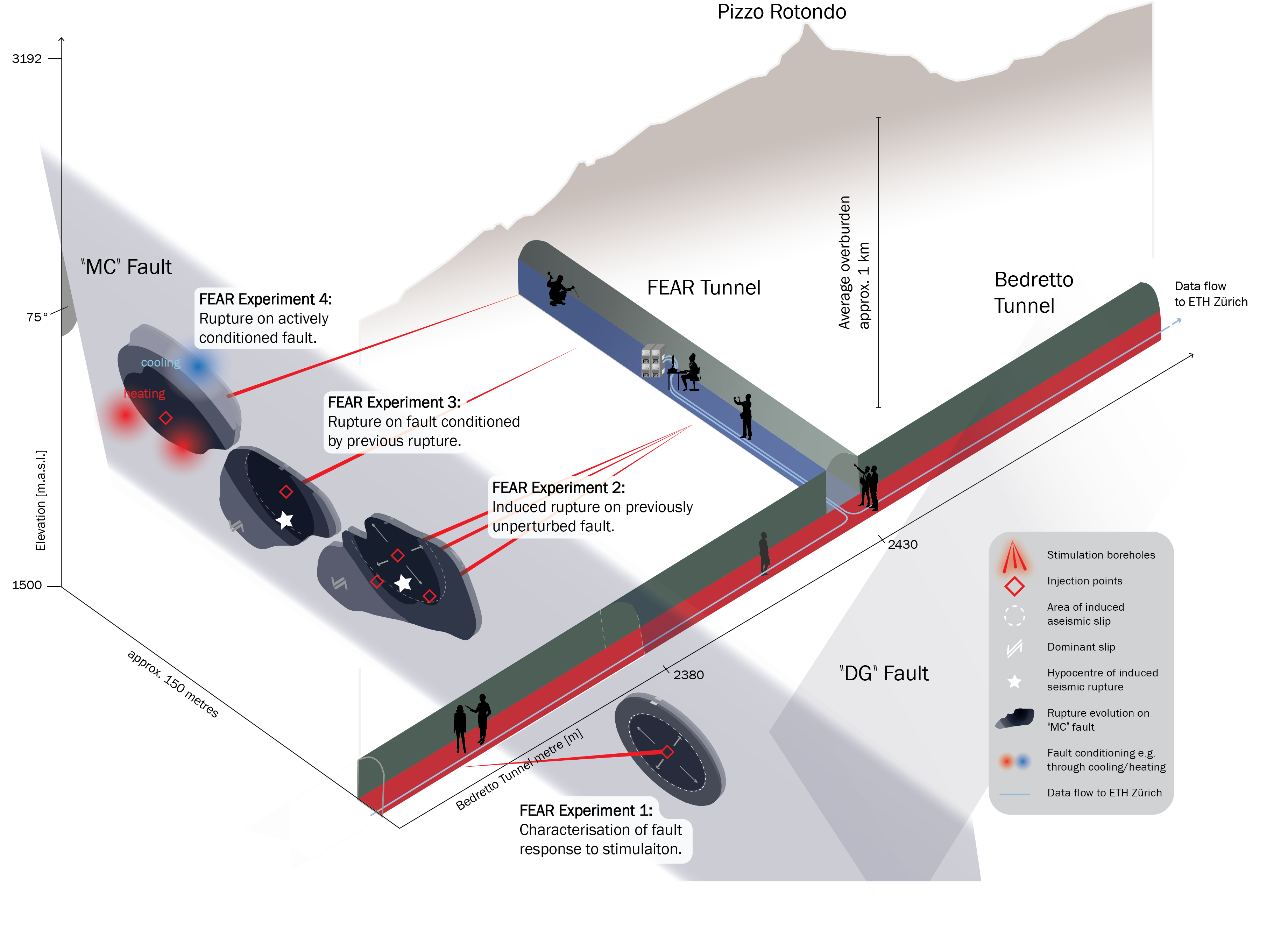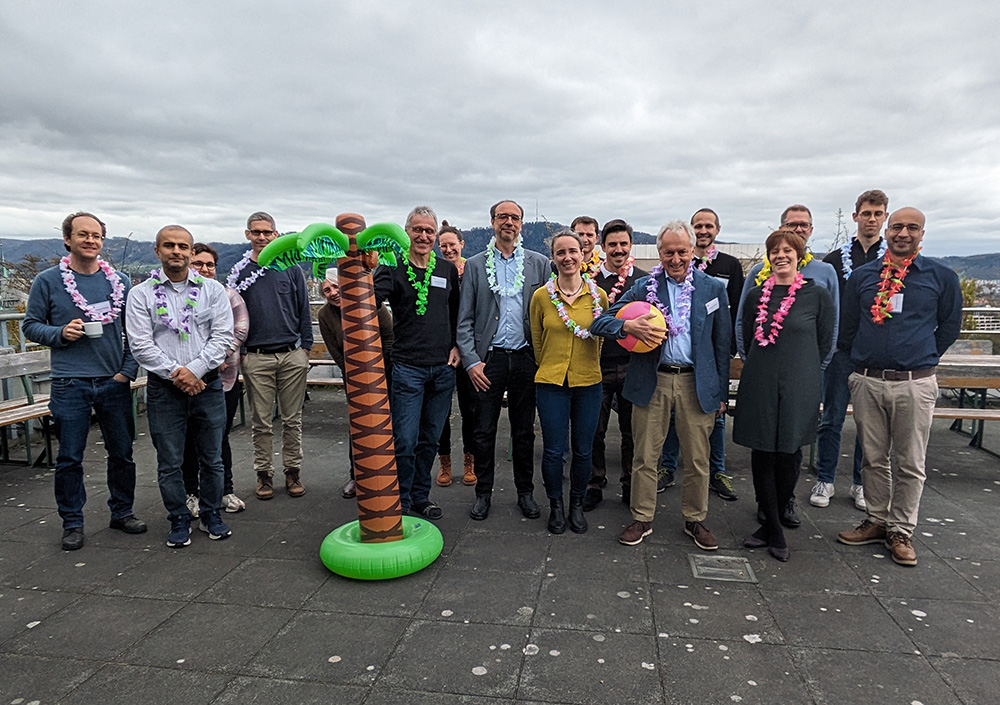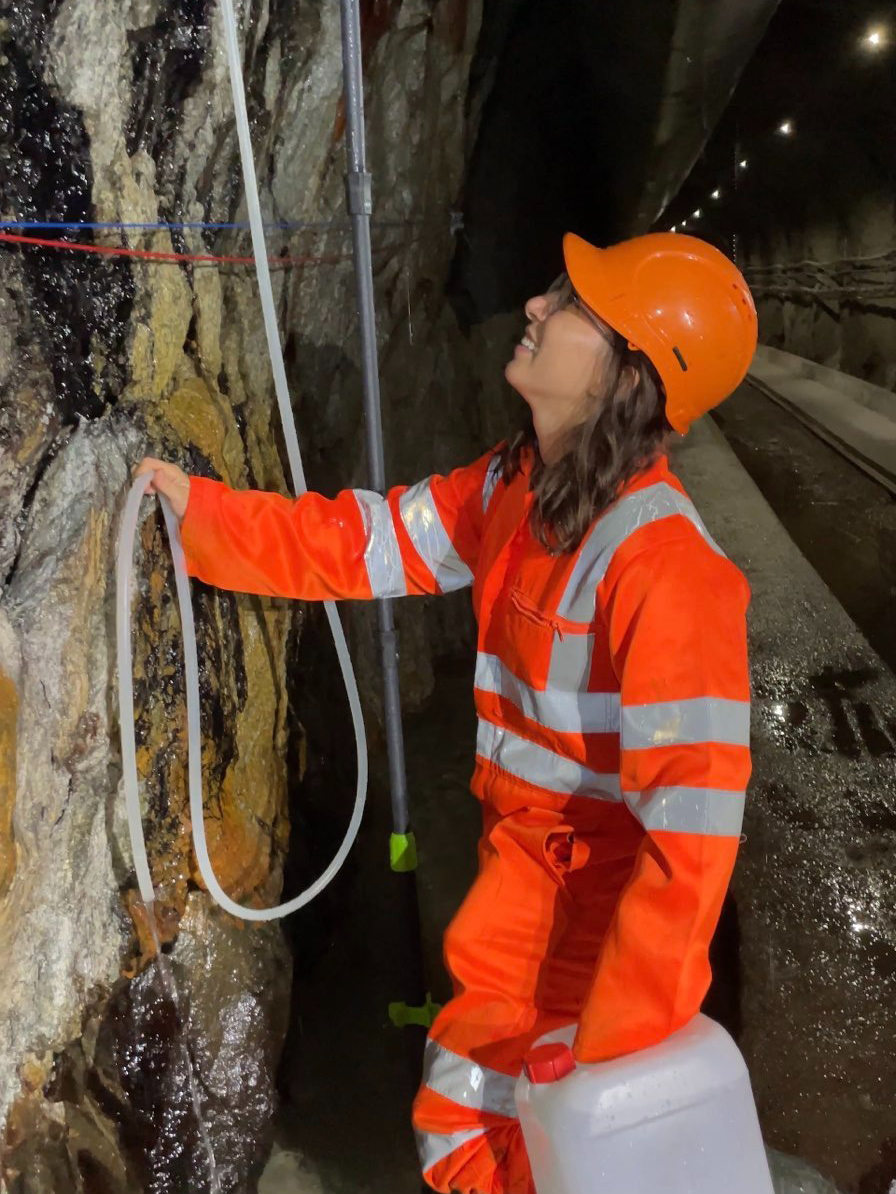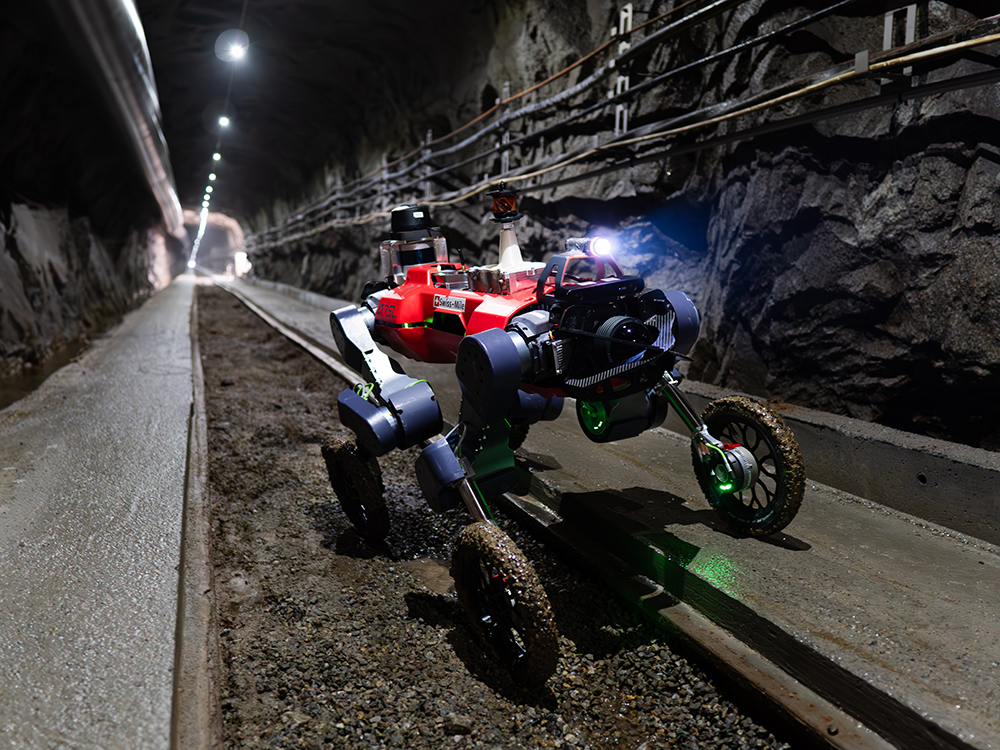2024-04-12
First long-term injection experiment starting in mid-April
The BedrettoLab team is embarking on a new phase of experiments. As part of the FEAR project, a sequence of hydraulic stimulation experiments will start in mid-April. Leveraging on insights gained from the VALTER experiments, the team plans continued injections for an extended period of two to four days, allowing the reactivation and extension of the fracture network of the reservoir created in past experiments. Scientifically, the team is focusing mainly on the seismic response of the reservoir and aims to scale up the seismicity to larger events than previously observed.
In past experiments, the largest observed micro-earthquake was about a magnitude -2; in the upcoming M0 experiment, the team strives to reach about a magnitude 0. Such an event is about 100 times larger in amplitude and releases about 1´000 times more energy than a magnitude -2. Such an event would rupture a patch of about two by two meters by about one centimetre, allowing us to study when and where such a micro-earthquake starts, how it ruptures, and when it stops. For comparison, a natural earthquake of magnitude 6 that occurs in Switzerland every 50 to 150 years ruptures a patch of 10 by 10 kilometres by one meter, releasing about 1 billion times more energy.
Magnitude 0 events have already occurred naturally in the vicinity of the tunnel, and such micro-earthquakes remain about 100 to 1’000 times too small to be felt by people in the Bedretto Valley at a distance of several kilometres. The likelihood of induced larger events that could be detected in the Bedretto Valley remains extremely low. However, even micro-earthquakes of magnitude zero to one can be felt if experienced within a few meters or tens of meters of them. To eliminate even the smallest risk to people in the tunnel, these experiments will not only be very closely monitored, but they will also for the first time be fully remote controlled. During the main injection, no people will be allowed in the tunnel. This remote-control capability will be even more important later in the FEAR project when patches of 10 meters are the target size.
During the main part of the experiment, about twenty dedicated members of the BedrettoLab team will be working in 24/7 shifts over a period of one week. Their primary task will be to monitor the pressure, flow rate, deformation, and seismicity behaviour in real-time. The geobiological and geochemical response of the reservoir will also be closely monitored, for example, to detect pre-cursors before larger ruptures. As implemented for previous experiments, two traffic light systems regulate the experiment, and if the observed vibrations or magnitude exceed pre-defined thresholds, the experiment will be ended immediately and bleed-off initiated; past experiments have shown that seismicity will then within minutes to hours decrease strongly.
2024-04-02
New project to test thermal energy storage in fractured rocks
A new project entitled ‘BEACH: Bedretto Energy Storage and Circulation of Geothermal Energy’ just started with a first meeting of the consortium. It is a pilot and demonstration project funded by the Swiss Federal Office of Energy (SFOE) dedicated to testing, developing, and introducing new technologies from research to the Swiss industrial market.
The project consortium consists of scientists from the BedrettoLab, the Geothermal Energy and Geofluids group at ETH Zurich, researchers from SUPSI, and industry experts from Azienda Elettrica Ticinese (AET) as well as Geo-Energie Suisse (GES).
BEACH will play a key role in tackling the challenges of the Swiss energy transition by demonstrating a new technology for storing and retrieving energy in the subsurface. With the energy grid shifting towards renewable energies such as wind or solar energy, seasonal phases of energy demand surplus demand for an efficient and sustainable solution for energy storage. While thermal energy storage in soft sediments (e.g. in the Netherlands) is well established, storing heat in the hard, fractured rock most common in Switzerland remains largely unexplored. The BEACH project will explore a so-called fractured thermal energy storage in the limited permeability of the crystalline rocks in the BedrettoLab.
For demonstrating the feasibility, warm water (30 - 70 °C) will be injected into existing fractures, where it will be stored and kept warm by the surrounding rock until it will be retrieved again. In a real-world roll-out scenario, the heat could then be converted into energy or used for district heating.
The tests are accompanied by comprehensive real-time-monitoring and numerical simulations for optimizing the geothermal energy system. Ultimately, the technology will be proposed on a cantonal and national level for real-scale sites to be realized by industrial partners as an additional part of the project. A real-scale reservoir in crystalline rock could be established close to infrastructures with high energy excess and/or demand, such as industrial areas, at depths of around 1 to 3 kilometers.
Maren Brehme from ETH Zurich leads the BEACH project awarded with a fund of 2.96 Mio CHF. The community of Bedretto and the canton of Ticino support the project in rolling out the technology on a national level.
2024-02-27
Looking deep into rocks and distant planets: geobiological research in the BedrettoLab
Cara Magnabosco is a professor in geobiology and together with her group she conducts research in the BedrettoLab. Cara is particularly interested in subsurface environments and looks for simple life-forms such as bacteria or other microorganisms that can survive by “breathing rocks”. One of the central questions she is exploring is under which conditions life can emerge and survive. In the BedrettoLab, she and her team have already found some fascinating and rare microorganisms. They are performing a variety of experiments to learn more about their lifestyle.
What is your research in the BedrettoLab about?
My research journey in the BedrettoLab started in 2020. In general, in my field, to get access to “deep ecosystems” is not easy. So, to have the BedrettoLab in such close distance and with almost permanent access is a big opportunity. At the beginning, we just wanted to find out what is there, in the boreholes and in the water that flows through the various fractures. We began to take many water samples to get an idea of the sampled water, where it originates from and what the chemistry looks like. Our aim is to identify energy sources in the water or on the rock surface that can feed microorganisms. Such energy sources include for example CO2 or nitrogen, which can be found in different amounts throughout the tunnel.
Once we got a better idea of what is existing, we also started to examine the effects of hydraulic stimulations on the microbiome, a term for the microogranisms that exist in a particular environment. We observed changes in the water chemistry and microbial populations during stimulations. Now, we maintain a geobiological monitoring borehole and “observe” the water chemistry and biology on a long-term basis with different permanent measuring installations. In this borehole we perform various experiments to better understand how the microorganisms in the BedrettoLab survive and evolve.
We have also installed additional monitoring stations to see if there are seasonal or experimental-associated changes in the system. We called the entire setup “DELOS” which stands for “Deep Life Observatory”, a tribute to the Greek island that shares the same name and prohibited dying. The microorganisms living in Bedretto’s DELOS have refused to die, even though they are hundreds to thousands of meters away from the sun and the surface.
What tools and methods do you use?
My team usually turns up in the tunnel with buckets and lots of bottles. With those vessels, we take our water samples directly from the boreholes or from a water source somewhere in the tunnel. Then we take the samples to our laboratory here at ETH Zurich and analyze them. This means that we look at water drops under the microscope, we do chemical analyzes or, if we identify interesting microorganisms, we try to cultivate them and do DNA sequencing. As we collect lots of data about the DELOS ecosystem as a whole, we also use machine learning to combine these data with the DNA analyses. Machine learning algorithms help us to identify patterns and ultimately connections between the environment or changes in it that lead to changes in the microorganisms, e.g. bacteria, and the occurrences of certain life forms.
Did you discover anything surprising during your research in the BedrettoLab?
We have found a large population of a set of extremely interesting ultra-small bacteria. They have extremely small genomes compared to complex life-forms such as plants and are among the smallest life-forms on earth. So, we are wondering, why exactly those bacteria do occur here, what do they need to survive and where are they originating from.
During the hydraulic stimulations we have also discovered a change in the water chemistry that is quite likely coming from the new fractures created in the rock. This means, when the rock breaks, a reaction is set in motion in which water molecules are split and hydrogen and oxygen is set free. What comes out is a highly reactive liquid that offers energy for potential life. We are wondering, if this was maybe an energy source for early life.
With your “Center for Origin and Prevalence of Life” you also open your eyes to other planets and the possibility of extraterrestrial life. What does your research have to do with life on other planets?
The reaction that I described earlier, where silicate rock, like the Rotondo granite and water react to produce bio-chemical energy, is quite generic. This means that it could also occur in the subsurface of other planets and power alternative ecosystems. This reaction pathway makes the existence of extra-terrestrial life more likely for example on Mars.
2024-01-24
ETH’s Robotic Systems Lab in the BedrettoLab
Last Friday, a group from ETH Zurich’s Robotic Systems Lab tested their wheeled-legged robot Chimera in the BedrettoLab. The robot is trained to serve for rescuing, logistics or monitoring in environments that are not accessible for humans. The BedrettoLab and the area in front of the tunnel entry proved to be an ideal environment for testing the robot's locomotion and navigation capabilities in a tough condition.




